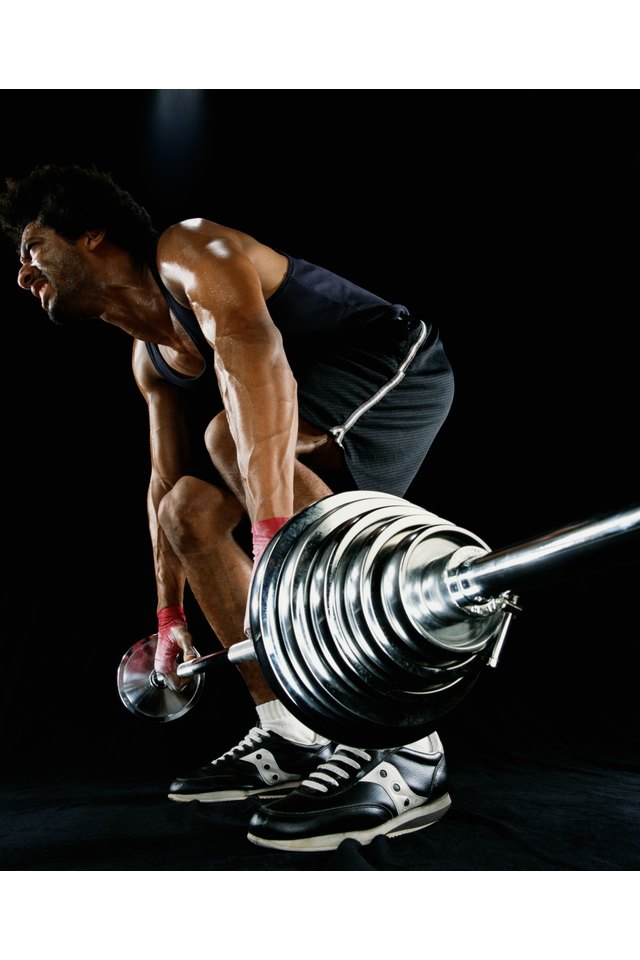Single Leg Deadlifts Vs. Two Legged Deadlifts

Deadlifts, whether done single-legged or two-legged, can be performed with either a pair of dumbbells or a barbell. The exercise is a compound weight training exercise, meaning it involves multiple joints and thus develops a large number of muscle groups. Doing the exercise while standing on one or two feet will tweak the technique slightly and thus recruit muscles differently.
Technique
The movements involved in both single-legged deadlift and two-legged deadlift are similar with the main difference being whether you stand on one or two legs. When performing deadlifts with both legs, position your feet so that they’re slightly wider than your shoulders with your toes pointed forward. During single-legged deadlifts, lift up your free foot up and hold it back behind you with your knee slightly bent. Hold the weight down in front of your thighs with your palms facing you. Bend forward at the waist, lowering the weight to the floor. If you’re doing single-legged deadlift, your free leg will extend behind you and you’ll return to a standing position once your back is parallel to the floor. If you’re doing two-legged deadlifts, you’ll bend your knees slightly more and return to a standing position after the weights touch the floor.
Muscles
Because of their similarities, according to the American Council on Exercise, both single-leg and two-legged deadlifts work nearly the same collection of muscle groups. The gluteus maximus, which is the major buttocks muscle, extend your hips and straightens you back up to a standing position. The erector spinae, which is a muscle that runs along your spine, contracts to keep your back straight and prevent it from collapsing to the floor. However, because two-legged deadlifts involve a greater degree of movement at the knees, your quadriceps is heavily involved. In addition, single-legged deadlifts require contribution from the latissimus dorsi and other muscles in your back.
Benefits of Single-Legged Deadlifts
Single-legged deadlifts require a greater degree of balance and coordination than two-legged deadlifts. As you lower towards the floor, the muscles in your feet, ankles, legs and hips will need to contract to stabilize your leg and prevent you from falling over. In addition, single-legged deadlifts will make each of your legs work independently. During two-legged deadlifts, your more dominant leg can take on a greater percentage of the load, thus allowing your non-dominant leg to get off easy. Single-leg deadlifts will ensure each leg has to handle the same amount of load.
Benefits of Two-Legged Deadlifts
If you’re looking to significantly build strength or size, two-legged deadlifts should appear in your workout regimen more often than single-legged deadlifts. You’ll be able to lift a significant greater amount of weight during two-legged deadlifts, which is what’s needed if you’re looking for serious strength gains. According to TheDeadlift.com, incorporating deadlifts will stimulate the release of both testosterone and growth hormone, which are involved in building muscle size.
References
- American Council on Exercise: Dumbbell Deadlift
- American Council on Exercise: Single-arm, Single-leg Romanian Deadlift
- The Deadlift.com: Physical Benefits of Deadlifting
- ExRx.net: Dumbbell Single-Leg Deadlifts
Writer Bio
Kim Nunley has been screenwriting and working as an online health and fitness writer since 2005. She’s had multiple short screenplays produced and her feature scripts have placed at the Austin Film Festival. Prior to writing full-time, she worked as a strength coach, athletic coach and college instructor. She holds a master's degree in kinesiology from California State University, Fullerton.
